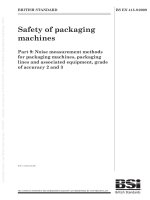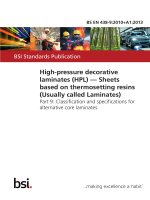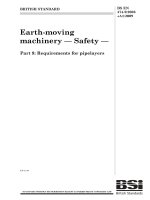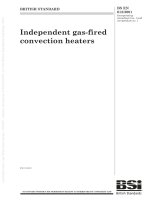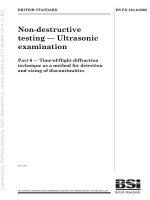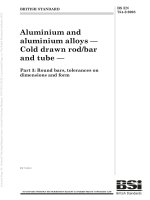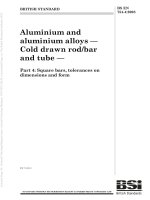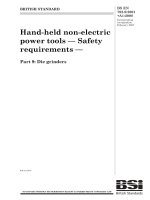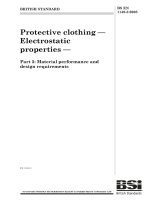Bsi bs en 01366 9 2008
Bạn đang xem bản rút gọn của tài liệu. Xem và tải ngay bản đầy đủ của tài liệu tại đây (542.36 KB, 48 trang )
BRITISH STANDARD
Fire resistance
tests for service
installations
Part 9: Single compartment smoke
extraction ducts
ICS 13.220.50
NO COPYING WITHOUT BSI PERMISSION EXCEPT AS PERMITTED BY COPYRIGHT LAW
BS EN
1366-9:2008
BS EN 1366-9:2008
National foreword
This British Standard is the UK implementation of EN 1366-9:2008.
The UK participation in its preparation was entrusted to Technical
Committee FSH/22, Fire resistance tests.
A list of organizations represented on this committee can be obtained on
request to its secretary.
This publication does not purport to include all the necessary provisions
of a contract. Users are responsible for its correct application.
Compliance with a British Standard cannot confer immunity
from legal obligations.
This British Standard
was published under the
authority of the Standards
Policy and Strategy
Committee on 31 August
2008
© BSI 2008
ISBN 978 0 580 59170 9
Amendments/corrigenda issued since publication
Date
Comments
BS EN 1366-9:2008
EUROPEAN STANDARD
EN 1366-9
NORME EUROPÉENNE
EUROPÄISCHE NORM
March 2008
ICS 13.220.50
English Version
Fire resistance tests for service installations - Part 9: Single
compartment smoke extraction ducts
Essai de résistance au feu des installations de service Partie 9 : Conduits d'extraction de fumées relatifs à un seul
compartiment
Feuerwiderstandsprüfungen für Installationen - Teil 9:
Entrauchungsleitungen für einen Einzelabschnitt
This European Standard was approved by CEN on 21 January 2008.
CEN members are bound to comply with the CEN/CENELEC Internal Regulations which stipulate the conditions for giving this European
Standard the status of a national standard without any alteration. Up-to-date lists and bibliographical references concerning such national
standards may be obtained on application to the CEN Management Centre or to any CEN member.
This European Standard exists in three official versions (English, French, German). A version in any other language made by translation
under the responsibility of a CEN member into its own language and notified to the CEN Management Centre has the same status as the
official versions.
CEN members are the national standards bodies of Austria, Belgium, Bulgaria, Cyprus, Czech Republic, Denmark, Estonia, Finland,
France, Germany, Greece, Hungary, Iceland, Ireland, Italy, Latvia, Lithuania, Luxembourg, Malta, Netherlands, Norway, Poland, Portugal,
Romania, Slovakia, Slovenia, Spain, Sweden, Switzerland and United Kingdom.
EUROPEAN COMMITTEE FOR STANDARDIZATION
COMITÉ EUROPÉEN DE NORMALISATION
EUROPÄISCHES KOMITEE FÜR NORMUNG
Management Centre: rue de Stassart, 36
© 2008 CEN
All rights of exploitation in any form and by any means reserved
worldwide for CEN national Members.
B-1050 Brussels
Ref. No. EN 1366-9:2008: E
BS EN 1366-9:2008
EN 1366-9:2008 (E)
Contents
Page
Foreword ............................................................................................................................................................. 4
Introduction ........................................................................................................................................................ 5
1
Scope...................................................................................................................................................... 6
2
Normative references ........................................................................................................................... 6
3
Terms and definitions........................................................................................................................... 7
4
4.1
4.2
4.3
4.4
4.5
4.6
4.7
4.8
4.9
4.10
4.11
4.12
4.13
Test equipment...................................................................................................................................... 7
General ................................................................................................................................................... 7
Furnace .................................................................................................................................................. 7
Perforated plate..................................................................................................................................... 8
Inlet nozzles (fire test) ........................................................................................................................ 10
Ambient leakage measuring device .................................................................................................. 10
Pressure sensors for differential pressure control ......................................................................... 10
Welded connecting tube..................................................................................................................... 10
Extract fan connecting duct............................................................................................................... 10
Extraction fan ...................................................................................................................................... 10
Thermocouples ................................................................................................................................... 10
Oxygen measuring equipment .......................................................................................................... 10
Restraint equipment ........................................................................................................................... 11
Observation window ........................................................................................................................... 11
5
5.1
5.2
Test conditions.................................................................................................................................... 11
Differential pressure conditions........................................................................................................ 11
Heating conditions.............................................................................................................................. 11
6
6.1
6.1.1
6.1.2
6.2
6.3
Test specimen ..................................................................................................................................... 11
Size ....................................................................................................................................................... 11
Length .................................................................................................................................................. 11
Cross-section ...................................................................................................................................... 11
Number................................................................................................................................................. 12
Design .................................................................................................................................................. 12
7
7.1
7.2
7.3
7.4
7.5
Installation of test specimen.............................................................................................................. 12
General ................................................................................................................................................. 12
Standard supporting construction.................................................................................................... 12
Duct arrangement ............................................................................................................................... 12
Restraint of ducts................................................................................................................................ 13
Perforated plate................................................................................................................................... 13
8
8.1
Conditioning ........................................................................................................................................ 13
General ................................................................................................................................................. 13
9
9.1
9.1.1
9.1.2
9.2
9.3
9.4
Application of instrumentation .......................................................................................................... 13
Thermocouples ................................................................................................................................... 13
Furnace thermocouples (plate thermometers) ................................................................................ 13
Gas temperature within flow nozzles................................................................................................ 14
Pressure ............................................................................................................................................... 14
Oxygen measurements....................................................................................................................... 14
Observations of reduction of cross-section .................................................................................... 14
10
Test procedure .................................................................................................................................... 14
10.1
Pre-test calibration.............................................................................................................................. 14
10.1.1 Oxygen-measuring instrument.......................................................................................................... 14
2
BS EN 1366-9:2008
EN 1366-9:2008 (E)
10.1.2
10.2
10.3
10.3.1
10.3.2
10.3.3
10.3.4
10.3.5
10.3.6
10.3.7
10.3.8
10.3.9
Perforated plate................................................................................................................................... 14
Leakage measurement at ambient temperature .............................................................................. 14
Fire test ................................................................................................................................................ 15
Extraction fan ...................................................................................................................................... 15
Ignition of furnace............................................................................................................................... 15
Furnace conditions ............................................................................................................................. 15
Temperatures and pressures............................................................................................................. 15
Oxygen measurements....................................................................................................................... 15
General observations ......................................................................................................................... 15
Reduction of cross-section................................................................................................................ 15
Leakage calculations .......................................................................................................................... 16
Termination of test.............................................................................................................................. 16
11
11.1
11.2
11.3
11.3.1
11.3.2
11.3.3
11.3.4
Performance criteria ........................................................................................................................... 17
General requirements ......................................................................................................................... 17
Criteria at ambient temperature......................................................................................................... 17
Criteria under fire conditions............................................................................................................. 17
General ................................................................................................................................................. 17
Leakage ................................................................................................................................................ 17
Reduction in cross-section ................................................................................................................ 17
Mechanical stability ............................................................................................................................ 17
12
Test report ........................................................................................................................................... 17
13
13.1
13.2
13.3
13.4
13.5
Direct field of application of test results .......................................................................................... 18
General ................................................................................................................................................. 18
Duct sizes ............................................................................................................................................ 18
Hangers ................................................................................................................................................ 19
Pressure difference............................................................................................................................. 19
Number of sides of duct ..................................................................................................................... 19
www.bzfxw.com
Annex A (informative) Measurement of volume/mass flow.......................................................................... 30
A.1
Hints on measuring volume flow or mass flow with differential pressure devices ..................... 30
A.2
Density ................................................................................................................................................. 30
A.3
Absolute Pressure (barometric pressure) ........................................................................................ 30
A.4
Viscosity .............................................................................................................................................. 31
A.5
Characteristic data of the inlet nozzles according to Figure 10 .................................................... 31
Annex B (informative) Measurement of oxygen content .............................................................................. 35
Annex C (informative) The usage of correction factors for the consideration of different
parameters ........................................................................................................................................... 39
3
BS EN 1366-9:2008
EN 1366-9:2008 (E)
Foreword
This document (EN 1366-9:2008) has been prepared by Technical Committee CEN/TC 127 “Fire
safety in buildings”, the secretariat of which is held by BSI.
This European Standard shall be given the status of a national standard, either by publication of an
identical text or by endorsement, at the latest by September 2008, and conflicting national standards
shall be withdrawn at the latest by September 2008.
Attention is drawn to the possibility that some of the elements of this document may be the subject of
patent rights. CEN [and/or CENELEC] shall not be held responsible for identifying any or all such
patent rights.
This document has been prepared under a mandate given to CEN by the European Commission and
the European Free Trade Association, and supports essential requirements of 89/106/EEC Directive.
EN 1366 "Fire resistance tests for service installations" consists of the following Parts:
Part 1: Ducts
Part 2: Fire dampers
Part 3: Penetration seals
Part 4: Linear joint seals
Part 5: Service ducts and shafts
www.bzfxw.com
Part 6: Raised access and hollow core floors (in course of preparation)
Part 7: Conveyor systems and their closures
Part 8: Smoke extraction ducts
Part 9: Single compartment smoke extraction ducts
Part 10: Smoke control dampers (in course of preparation)
Part 11: Protective systems for essential services (in course of preparation)
According to the CEN/CENELEC Internal Regulations, the national standards organizations of the
following countries are bound to implement this European Standard: Austria, Belgium, Bulgaria,
Cyprus, Czech Republic, Denmark, Estonia, Finland, France, Germany, Greece, Hungary, Iceland,
Ireland, Italy, Latvia, Lithuania, Luxembourg, Malta, Netherlands, Norway, Poland, Portugal, Romania,
Slovakia, Slovenia, Spain, Sweden, Switzerland and the United Kingdom.
4
BS EN 1366-9:2008
EN 1366-9:2008 (E)
Introduction
This part of this European Standard has been prepared because a method of test for smoke
extraction ducts used in single compartment applications has become necessary. This test exposes a
smoke extraction duct to conditions intended to represent the pre-flashover stage of a fire.
Leakage is measured at both ambient temperature and exposure at 600 °C. During the tests,
air/gases are drawn through the duct at a differential pressure between the inside and outside of the
duct. Leakage is determined at ambient temperature by sealing the openings in the duct located in the
furnace and taking flow measurements through a flow measuring device located just before the
extraction fan. With respect to determining leakage at 600 °C, oxygen-measuring techniques are
used.
CAUTION — The attention of all persons concerned with managing and carrying out this fire
resistance test is drawn to the fact that fire testing may be hazardous and that there is a possibility
that toxic and/or harmful smoke and gases may be evolved during the test. Mechanical and
operational hazards may also arise during the construction of the test elements or structures, their
testing and disposal of test residues.
An assessment of all potential hazards and risks to health should be made and safety precautions
should be identified and provided. Written safety instructions should be issued. Appropriate training
should be given to relevant personnel. Laboratory personnel should ensure that they follow written
safety instructions at all times.
www.bzfxw.com
5
BS EN 1366-9:2008
EN 1366-9:2008 (E)
1
Scope
This part of EN 1366 specifies a test method for determining the fire resistance of smoke extraction
ducts that are used for single compartment applications only. In such applications, the smoke
extraction system is only intended to function up to flashover (typically 600 °C).
This method of test is only suitable for ducts constructed from non-combustible materials (euro
class A1 and A2-s1, d0).
It is applicable only to four sided and circular ducts. One, two and three sided ducts are not covered.
This test has been designed to cover horizontal smoke extraction ducts intended for single
compartment applications only.
This test method of part 9 is applicable only to smoke extraction ducts that do not pass through into
other fire compartments. It represents fire exposure of a developing fire (pre-flashover). For smoke
extraction ducts that pass through into other compartments, the method of test described in EN 13668 should be used.
The smoke extraction duct is part of the smoke extraction system which also includes smoke control
dampers and smoke extract fans.
The method described in this test standard is complex and requires sophisticated instrumentation. It is
not recommended therefore to try to test multiple assemblies in this test.
2
Normative references
www.bzfxw.com
The following referenced documents are indispensable for the application of this document. For dated
references, only the edition cited applies. For undated references, the latest edition of the referenced
document (including any amendments) applies.
EN 1363-1:1999, Fire resistance tests - Part 1: General requirements
EN 1363-2, Fire resistance tests - Part 2: Alternative and additional procedures
EN 1366-1:1999, Fire resistance tests for service installations - Part 1: Ducts
EN 1751, Ventilation for buildings - Air terminal devices - Aerodynamic testing of dampers and valves
EN 60584-1, Thermocouples - Part 1: Reference tables (IEC 60584- 1:1995)
EN ISO 5167-1, Measurement of fluid flow by means of pressure differential devices inserted in
circular cross-section conduits running full - Part 1: General principles and requirements (ISO 51671:2003)
EN ISO 13943:2000, Fire safety - Vocabulary (ISO 13943:2000)
ISO 5221, Air distribution and air diffusion - Rules to methods of measuring air flow rate in an air
handling duct
6
BS EN 1366-9:2008
EN 1366-9:2008 (E)
3
Terms and definitions
For the purposes of this document, the terms and definitions given in EN 1363-1:1999 and EN
ISO 13943:2000 and the following apply.
3.1
single compartment smoke control system ducts
ducts for use within single fire compartment application
3.2
suspension devices
the components used for suspending and fixing a duct from a floor soffit or supporting a duct from a
wall
3.3
supporting construction
the wall, partition or floor which the duct passes through in the test
3.4
single fire compartment
fire area of a single compartment building bounded by fire-resistant walls
3.5
smoke zone (zones)
areas into which a construction work is divided for the extraction of smoke and hot gases. Each zone
is served by a SHEV (or sub-system of a SHEV), which is initiated by a signal from a single or group
of initiation devices associated with the zone
www.bzfxw.com
3.6
smoke barrier
a barrier to restrict the spread of smoke and hot gases from a fire, forming part of the boundary of a
smoke reservoir or used as a channelling screen, or used as a void edge boundary
3.7
compensator
a device that is used to prevent damage from the forces generated by expansion
3.8
smoke and heat exhaust ventilation system (SHEVS)
system consisting of products and/or components jointly selected to exhaust smoke and heat. The
products and/or components form a system in order to establish a buoyant layer of warm gases above
cooler cleaner air
4
4.1
Test equipment
General
In addition to the test equipment specified in EN 1363-1, the equipment in 4.2 and 4.3 is required. The
overall test arrangement is shown in Figure 1. Details of instrumentation and other details are shown
in Figures 2 to 10.
4.2
Furnace
The furnace shall be capable of subjecting fire resisting smoke extraction ducts to the standard
heating and pressure conditions specified in EN 1363-1 and be suitable for testing ducts in the
horizontal orientation (see Figure 1).
7
BS EN 1366-9:2008
EN 1366-9:2008 (E)
4.3
Perforated plate
The perforated plate controls the flow through the duct so that the required differential pressure, see
Table 1, can be achieved. Depending on the end-use conditions, a pressure level from Table 1 shall
be selected. These levels correspond to typical values used in smoke extraction design.
The plate shall be positioned (250 ± 50) mm from where the duct passes through the furnace wall
(see Figures 1 and 2).
These plates shall be made from heat resisting steel, 19 % min. Cr content and 11 % min. Ni content.
The number of holes and dimensions are given in Tables 2 and 3. The thickness of the plates shall be
2,5 mm.
Table 2 gives details of perforated plates for standard rectangular ducts of size 1 000 mm x 250 mm.
For smaller sizes, the number of holes will be reduced proportional to the smaller cross-section.
Table 3 gives details of perforated plates for standard circular ducts of diameter 560 mm. For smaller
sizes, the number of holes will be reduced proportional to the cross-section (a change to larger sizes
is not accepted; see 6.1.2 and Table 5).
Further details of the plate are shown in Figures 2, 3 and 4.
Table 1 — Differential pressures between inside and outside the duct for smoke extraction
ductwork
Pressure Level1)
Operating differential pressure at
ambient temperature
Pa
-500
-1 000
-1 500
Differential pressure for the
fire test and pre-test calibration
Pa
-150
-300
-500
www.bzfxw.com
1
2
3
Table 2 — Details of perforated plates for testing rectangular ducts (see Figure 3)
1)
Specification for perforations
Total number of holes
Number of holes - horizontally
Number of holes - vertically
Diameter of hole (mm)
Horizontal distance from rim e (mm)
Vertical distance from rim c (mm)
Mounting hole separation a (mm)
Mounting hole separation b (mm)
1)
8
see Clause 5.
1
550
50
11
10
15
15
19,8
21,8
Pressure level
2
407
37
11
10
15
15
26,9
22
3
324
36
9
10
20
20
27,4
26,3
BS EN 1366-9:2008
EN 1366-9:2008 (E)
Table 3 — Details of perforated plate for testing circular ducts (see Figure 4)
1)
Specification for perforations
Total number of holes
Diameter of hole (mm)
Horizontal distance from rim e (mm)
Mounting hole separation a (mm)
1
541
10
30
Pressure level
2
403
10
35
23
3
319
10
35
25,5
9
BS EN 1366-9:2008
EN 1366-9:2008 (E)
4.4
Inlet nozzles (fire test)
Each nozzle shall have an internal dimension of 160 mm (see Figure 10, suitable for the standard
sizes of ducts specified in 6.1) in accordance with EN ISO 5167-1 and ISO 5221, and shall be suitably
mounted to the end of the duct with its piezometric ring connected to appropriate differential pressure
measuring equipment. The measuring device shall be capable of measuring to an accuracy of ± 5 %.
4.5
Ambient leakage measuring device
Ambient leakage measuring shall be in accordance with EN ISO 5167-1 and ISO 5221 and suitably
mounted to the end of the duct, connected to appropriate differential pressure measuring equipment.
The measuring device shall be capable of measuring to an accuracy of ± 5 %.
4.6
Pressure sensors for differential pressure control
A tube sensor as specified in EN 1363-1 shall be located at the end of the duct, inside the duct, at the
level of its centre line. A second sensor (e.g. an open end of a measuring tube) shall be located on
the same level outside the duct.
A flow control damper shall be provided for a fine control for maintaining the required differential
pressure. Alternatively, another suitable device such as a variable speed fan may be used. Any flow
control damper shall be attached to the extract fan connecting duct (see 4.8).
4.7
Welded connecting tube
A welded connecting tube is a tube designed to provide a suitable gas tight connection between the
inlet nozzles and the oxygen measuring probes shall be provided (for details see Figure 6).
4.8
Extract fan connecting duct
An extract fan connecting duct is a duct designed to connect between the test specimen and the
extraction fan. An inlet opening may be provided if a flow control damper is used for fine control of the
differential pressure (see 4.6).
4.9
Extraction fan
An extraction fan is a fan for extracting gas under test with a suction capacity of at least 2 x Vn where
3
Vn is the required capacity e.g. for a stated cross-section of Vn = 0,25 m x 1 m, 2 x Vn = 0,5 m /s.
The characteristic curves of the fan shall be horizontal for the actual airflow. The capacity of the fan
shall not change by more than 10 % in the event of a drop in the pressure of up to 50 Pa.
4.10 Thermocouples
1,5 mm sheathed thermocouples shall be provided for measuring the gas temperature adjacent to the
nozzles. An alternative thermocouple may be used, provided it can be shown to have equivalent
response time.
4.11 Oxygen measuring equipment
Equipment for measuring the oxygen content of gases shall be provided. This system shall consist of
paramagnetic cell oxygen analysers together with appropriate equipment for cooling, filtering and
drying the gases. Appropriate connecting tubes and probes shall be provided. The 90 % response
time of the complete system shall be 20 s maximum. The accuracy shall be better than ± 0,1 vol %.
10
BS EN 1366-9:2008
EN 1366-9:2008 (E)
4.12 Restraint equipment
Restraining equipment shall be applied as for duct B in EN 1366-1:1999.
4.13 Observation window
An observation window shall be provided between the two nozzles and a suitable method of viewing
from a safe distance shall be provided (a mirror arrangement may be found suitable). If the reduction
in cross-section of the duct can be assessed sufficiently from the outside (see 9.4), then the
observation window may be omitted.
5
Test conditions
5.1
Differential pressure conditions
Depending on the end-use conditions, a pressure selected from Table 1 shall be selected. These
levels correspond to typical values used in smoke extraction design.
5.2
Heating conditions
The heating conditions and the furnace atmosphere shall conform to those specified in EN 1363-1 (or,
if applicable, EN 1363-2) until 600 °C is reached. The mean temperature of the six furnace
thermocouples shall reach 600 °C between 5 min to 10 min from igniting the first furnace burner. After
10 min this temperature shall be maintained between +70 °C, -0 °C for the rest of the test.
The furnace pressure shall be controlled to (15 ± 3) Pa throughout the test at the mid-height position
of the ducts in the furnace.
Details of test conditions within the duct during the test are given in Clause 10.
6
Test specimen
6.1
6.1.1
Size
Length
The minimum lengths of the parts of the test specimen inside and outside the furnace shall be as
given in Table 5 (see also Figure 1).
Table 4 — Minimum length of test specimen
Orientation
Horizontal
6.1.2
Inside furnace
3,0
Minimum length (m)
Outside furnace
4,2
Cross-section
The sizes of duct given in Table 6 shall be tested unless smaller cross-sections are required for
specific applications.
11
BS EN 1366-9:2008
EN 1366-9:2008 (E)
Table 5 — Cross-section of test specimen
Rectangular
Width (mm)
1000
6.2
Height (mm)
250
Circular
Diameter (mm)
560
Number
One test specimen shall be tested for each type of installation to be evaluated.
6.3
Design
The test shall be made on a test specimen representative of the complete duct. Each type of duct
requires a different approach and an attempt shall be made to reproduce the edge conditions and the
method of fixing or support inside and outside the furnace representative of that used in practice. The
distance between hangers or supports shall be representative. Where compensators are used in
practice, then they shall be incorporated in the test specimen. In this case, the compensator shall be
located outside the furnace, approximately 500 mm from the perforated plate.
7
7.1
Installation of test specimen
General
The test specimen shall be installed, as far as practicable, in a manner representative of its use in
practice.
The fire-stopping at the penetration through the supporting construction shall be sufficient to prevent
leakage of furnace gases.
Parts of the ducts within the furnace shall be exposed to fire from all sides over their whole length.
7.2
Standard supporting construction
A standard supporting construction shall be selected from the specifications detailed in
EN 1366-1:1999.
Where the duct passes through an opening in the furnace wall, the opening shall be of sufficient
dimensions to allow for the supporting construction to surround all faces of the duct by at least
200 mm.
To ensure that leaking furnace gas does not occur, it is important that the supporting construction and
furnace roof is well sealed where it contacts the furnace wall.
7.3
Duct arrangement
7.3.1 A single duct may be tested in the furnace, or alternatively, two or more ducts may be tested
in the same furnace, provided that there is sufficient space to do so, in accordance with the
dimensions shown in Figure 1.
7.3.2 Ducts shall be arranged as shown in Figure 1. The end of the ducts within the furnace shall
be closed independently of any furnace enclosure by materials and construction similar to the
remainder of the duct.
12
BS EN 1366-9:2008
EN 1366-9:2008 (E)
7.3.3 The test arrangement shall include at least one joint or flange connection inside the furnace
and at least one joint or flange connection outside it (see Figure 1). Any stiffeners used to maintain
the cross-section of the duct shall be arranged at the positions and centres specified by the sponsor.
The distance between joint and hangers shall not be less than intended in practice. If the minimum
distance has not been specified, hangers shall be arranged so that the joint at mid-span lies midway
between them. Centres of the hangers should be specified by the manufacturer and shall be
representative of practice.
7.3.4 Two openings shall be provided, one on each vertical side of the duct inside the furnace. The
openings shall be positioned (500 ± 25) mm from the furnace wall. Each opening shall have the same
breadth/height ratio as the cross-section of the duct and have a total opening area of (50 ± 5) % of the
cross-sectional area of the duct. For circular ducts the total opening may be square or circular (Each
opening will have an area of (25 ± 5) % of the cross-sectional area of the duct).
7.3.5 There shall be a clearance of (500 ± 50) mm between the top of the duct and the ceiling and
at least 500 mm between the underside of the duct and the floor. Similarly, there shall be a clearance
of at least 500 mm between the sides of the duct and furnace walls.
7.4
Restraint of ducts
Inside the furnace, the duct will be fully restrained in all directions at the furnace wall or floor remote
from the penetration point (see Figure 7). Where there is a possibility of the furnace wall moving, then
the fixings shall be made to be independent of the furnace structure. The outside of the duct shall be
restrained as shown in EN 1366-1:1999.
7.5
Perforated plate
The perforated plate shall be located (250 ± 50) mm from the external face of the supporting
construction. Provision shall be made for the plate to be removed, if necessary during the pre-test
calibration described in 10.1.
8
Conditioning
8.1
General
Conditioning of the test construction shall be in accordance with EN 1363-1.
8.2
Water based sealing materials
Conditioning of water base sealing materials shall be in accordance with EN 1366-8.
9
Application of instrumentation
9.1
9.1.1
Thermocouples
Furnace thermocouples (plate thermometers)
Plate thermometers shall be provided in accordance with EN 1363-1 and shall be positioned as
shown in Figures 8 and 9. Side A of the plate thermometers shall face the wall of the furnace that is
parallel to the longer side of the duct.
13
BS EN 1366-9:2008
EN 1366-9:2008 (E)
9.1.2
Gas temperature within flow nozzles
The gas temperature thermocouples (type K according to EN 60584-1) adjacent to the nozzles shall
be arranged with the measuring junction located at the centre line of each nozzle. The distance
between the measuring junctions and the inlet of the nozzle is shown in Figure 5 and Figure 6. An
alternative thermocouple may be used provided it can be shown to have equivalent response time.
9.2
Pressure
For measurement of the differential pressure between the inside and outside the duct, the pressure
probe shall be located horizontally at the end of the duct in the level of centre line of the inlet nozzles
as shown in Figures 5 and 6 (Pos. D1).
9.3
Oxygen measurements
Oxygen measurements shall be made using a sensor manufactured from stainless steel tube, having
approximate dimensions 6 mm outside diameter and 5 mm internal diameter, which shall be located
inside the duct 100 mm upstream from the perforated plate on the centre line of the duct (G1). A
second sensor (G2) shall be located after the nozzles at a distance of 100 mm on the centre line of
the connecting box (see Figures 5 and 6 for details). Each sensor is connected by suitable pipework
to its own single oxygen-measuring instrument.
9.4
Observations of reduction of cross-section
To facilitate observations of reduction of cross-section, an observation window shall be located
between the two nozzles or other suitable places.
10 Test procedure
10.1 Pre-test calibration
10.1.1 Oxygen-measuring instrument
Calibrate the measuring instrument just prior to the fire test.
10.1.2 Perforated plate
Switch on the extract fan. Check that both the required differential pressure and air velocity of 2 m/s
are obtained under ambient conditions. Ensure the air velocity is within ± 15 % and the differential
pressure is within ± 3 %. However, if these values cannot be achieved, switch off the fan, remove the
perforated plate and as appropriate, drill additional holes or seal some holes using screws. Replace
the perforated plate and repeat the procedure until the required values have been achieved.
NOTE
The initial check on the perforated plate should be undertaken on a duct section provided for the
purpose and not the test specimen where the removal of the plate may create problems.
10.2 Leakage measurement at ambient temperature
10.2.1 Seal the two openings in the duct that are located inside the furnace.
10.2.2 Switch on the extract fan, making any fine adjustments so that the differential pressure
reading is within ± 3 % of the prescribed value given in Table 1 throughout the time over which the
leakage measurements are taken.
14
BS EN 1366-9:2008
EN 1366-9:2008 (E)
NOTE
The pressure level may be selected by the sponsor. Alternatively it is possible for the sponsor to
change to another pressure level depending on the leakage criteria in compliance with 11.2.
10.2.3 Switch on measuring equipment related to the ambient leakage measuring device.
10.2.4 After stable conditions are achieved, for a period of not less than 5 min measure and record
the pressure differential through to the ambient leakage measuring device at the selected pressure
level. Where information is required on leakage at other pressure levels, repeat the procedure
described in 10.1.2 to 10.2.4. Calculate the airflow in accordance with EN ISO 5167-1 and ISO 5221.
10.2.5 Switch off measuring equipment and the extraction fan.
10.2.6 Remove sealing from openings.
10.3 Fire test
10.3.1 Extraction fan
Switch on the extraction fan and make any adjustments to the damper or fan to maintain the
differential pressure at the selected pressure level given in Table 5.
10.3.2 Ignition of furnace
Switch on all measuring equipment and ignite the furnace. The time for the evaluation of test data
starts in accordance with EN 1363-1:1999, 10.3.
10.3.3 Furnace conditions
Throughout the test, maintain the furnace conditions to comply with the requirements of Clause 5.
Make any adjustments necessary to maintain the differential pressure readings inside the duct to
within ± 3 % of the appropriate value given in the third column of Table 1 after 5 min of the start of the
test.
10.3.4 Temperatures and pressures
Record all temperatures and pressures at the intervals specified in EN 1363-1.
10.3.5 Oxygen measurements
After the first fifteen minutes of the test, start recording the oxygen measurement, readings being
taken at the furnace location and then at the nozzle location.
10.3.6 General observations
Take observations on the general behaviour of the duct throughout the test, in particular observe for
collapse of any part of the duct inside and outside of the furnace that would effect the liability of
function for the purpose for which it is intended.
10.3.7 Reduction of cross-section
Throughout the test, take measurements around the top and bottom outside surface and both sides of
the duct outside the furnace to determine any reduction in cross-section of the duct.
These measurements shall be taken at three locations outside the furnace between the perforated
plate and the end of the duct. Supplement these measurements by observations. As soon as possible
after the end of the fire test, remove sufficient of the apparatus to allow the inside of the tested duct to
be examined so that any reduction in cross-section can be verified.
15
BS EN 1366-9:2008
EN 1366-9:2008 (E)
10.3.8 Leakage calculations
Using the values recorded, calculate the leakage from the O2 measurements as follows:
mL =
Cf × mG2 × ( cG2 − cG1 )
21 − cG1
where
mL is the leakage mass flow (kg/s)
mG2 is the mass flow at point G2 near inlet nozzles (kg/s)
cG1 is the oxygen content of first sensor (vol-%)
21 is the oxygen concentration of ambient standard atmosphere (vol-%)
cG2 is the oxygen content of second sensor (vol-%)
Cf
the correction factor, is determined as follows:
Cf = 0,94 for liquid fuel (oil)
Cf = 0,91 for gas
NOTE
Gaseous fuel (natural gas H = high and L = low) with approximately 85 to 100 vol-% concentration of
methane (CH4), see Annex B and C.
VL shall be used to determine compliance with the leakage criteria stated in 11.3 and is calculated
as:
VL =
mL
ρ
where
3
VL is the leakage volume flow (m /s)
ρ
3
is the density of dry air at 20 °C/1013 hPa (= 1,2 kg/m )
10.3.9 Termination of test
The test may be terminated
a) at the request of the sponsor;
b) at end of classification period (or if a serious failure occurs);
c) when criteria is exceeded leakage (but this may need to be calculated after the test); if duct inside
furnace collapses and reduction of cross-section (confirmed after test).
16
BS EN 1366-9:2008
EN 1366-9:2008 (E)
11 Performance criteria
11.1 General requirements
Under the specified pressure conditions given in Table 1, the fire resisting smoke extraction duct shall
satisfy the requirements given in 11.2 and 11.3. In addition, smoke extraction ductwork shall be made
of non-combustible materials that are classified A1 and A2-S1, d0.
The pressure levels are distinguished for smoke extraction ductwork. In the course of testing smoke
extraction ductwork in accordance with Clause 10, the pressure levels defined in Table 5 shall be
observed.
11.2 Criteria at ambient temperature
Smoke extraction ductwork of all pressure levels intended for installation remote from the fire zone
3
2
from which smoke is to be extracted, shall not have a leakage exceeding 10 m /h per 1 m of total
internal surface area of the complete duct (inside and outside the furnace) when tested in accordance
with 10.2.
11.3 Criteria under fire conditions
11.3.1 General
When tested in accordance with 10.3, smoke extraction ductwork for use in combination with smoke
exhaust fans and which is intended to extract smoke from the compartment to outside, without
passing through other compartments, shall comply with 11.3.2 to 11.3.4.
11.3.2 Leakage
3
2
The duct shall not have a leakage exceeding 10 m /h per 1 m of internal surface area. This shall be
related to the surface area of the duct from the perforated plate to the end of the duct by the inlet
nozzles.
11.3.3 Reduction in cross-section
The internal dimensions (width and height for rectangular ducts, diameter for circular ducts) of the
smoke extracting ductwork shall not decrease by more than 10 % during the test inside and outside of
the furnace. This shall be by the measurements taken in accordance with 10.3.7.
11.3.4 Mechanical stability
If the duct inside the furnace collapses such that the performance of the duct cannot be maintained,
this shall be regarded as failure under this criterion. The critical opening area should be 50 % of the
nominal cross section of the duct.
12 Test report
In addition to the items required by EN 1363-1, the following shall also be included in the test report.
a)
The method of fixing, support and mounting, as appropriate for the type of specimen, and a
description of the method and materials used to seal the gap between the duct and opening
provided in the wall to accommodate the duct, the details of the supporting construction.
b)
Other observations made during the test including a complete record of the following test
parameters as a function of time:
17
BS EN 1366-9:2008
EN 1366-9:2008 (E)
1)
furnace temperature;
2)
furnace pressure;
3)
volume flow measuring station gas temperatures;
4)
volume flow measuring station pressure differential;
5)
calculated volume flow rate;
6)
7)
differential pressure between inside and outside the duct (negative values indicate
underpressure);
oxygen-concentration.
c)
Details of the leakage measured in accordance with 10.2 and 10.3.8. Where the test is
terminated before the occurrence of failure under the relevant criteria, this shall be reported.
d)
Where steel ducts are used, the thickness, leakage class to EN 1751 and details of any external
stiffening or internal stiffeners if incorporated.
e)
Full calculations in accordance with 10.3.8.
f)
All measurements and observations recorded in respect to reduction in cross-section.
13 Direct field of application of test results
13.1 General
The requirements for direct field of application of test results for all ducts tested to this standard apply
to
all temperatures below 600 °C;
same time duration;
same pressure level.
13.2 Duct sizes
A test result obtained for the standard sizes of duct specified in 6.1 is applicable to all dimensions up
to the size tested together with a maximum size given in Table 6.
Table 6 — Applicability of duct size tested to other sizes
Tested standard size:
Maximum sizes up to:
Decrease of size:
18
Rectangular
Width mm
Rectangular
Height mm
Circular
Diameter mm
1 000
1 250
No limit
250
1 000
No limit
560
1 000
No limit
